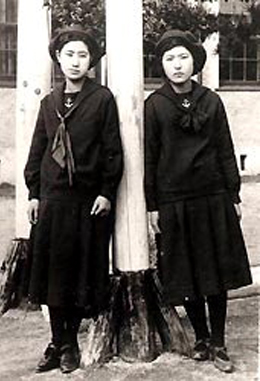Despite or perhaps because of their prevalence in anime, sailor fuku is one of the more misunderstood articles of clothing out there – particularly by viewers who watch anime only now and again, or have little familiarity with Japanese culture as a whole.
The two most common questions seem to be, ‘why is her skirt so short?’, and ‘why do the characters wear their school uniforms even when not at school?’
As a result, the idea that the sailor fuku acts primarily as some sort of fetish item seems to be a reasonably common one.
First introduced in 1921 by Elizabeth Lee, the principal of Fukuoka Jo Gakuin University, the sailor fuku was modelled after the uniforms worn by the Royal Navy, which Lee had seen as an exchange student in the United Kingdom.
 |
| Sailor fuku, circa 1921 |
Today, school uniforms are almost universal in both Japanese private and public school systems, required from after elementary school through to the end of high school (students from about 12 to 18 years old). The specific design and colours of the uniforms depend entirely on the school, although they are distinctive enough that people from any given area can usually tell who goes to which school.
Although the sailor-style collar and tie is not necessarily a part of every uniform, they are seen mostly on middle-school students, whereas high school uniforms are more likely to consist of a skirt and blouse/blazer combo with a thin ribbon or Western long-tie rather than the large Sailor Moon-style bow, or else simply a pinafore dress over a blouse like in Evangelion.
 |
| Sailor Moon |
However, all styles may still be correctly referred to as sailor fuku.
Sailor fuku are also often seen as a fashion statement by the students, and it is not unheard of for girls to select which junior high school they attend based on the uniform.
Indeed, personalised sailor fuku also play a large role in Japanese youth culture, and have done so for decades. As in the West, uniforms are sometimes modified by students as a means of exhibiting individualism and experimenting with their image and identity – although the more upper-class or exclusive the school, the less likely these modifications are to be tolerated.
The shortening, or in some cases lengthening, of the skirt, the removal of the ribbon, necktie, or bow, and the hiding of patches and badges beneath the collar are some of the more widespread changes that are made to school uniforms by their wearers.
However, like any other fashion, what is considered trendy changes with the times.
In the late 1960s and early 1970s, the sukeban style became the stylish thing, and ‘bad girls’ wanting to emulate the girl gang look wore their skirts to ankle-length and their tops to bare their midriffs, completing the outfit with Converse sneakers – much like Fruits Basket’s ex-gang member Arisa. In contrast, the gyaru styles, which reached their peak during the mid-1990s, dictated that school skirts be worn short by rolling up the waistband, and that loose white socks be fixed below the knee with the aid of a special sock glue. Students imitating this particular style also often tanned their skin, bleached their hair, and wore a lot of pale make-up – as seen by Ran in Super Gals! (kogal fashion) or the three heavily made-up high school girls in Durarara!! (ganguro fashion).
Exactly why the sailor fuku is seen so often in anime can be answered by examining some basic cultural facts.
Societal rules dictate that school uniforms be used as student formal-wear, and are therefore worn to any event that may have bearing on the school itself. These include weddings, funerals, and sports events, to name just a few examples.
Moreover, because it is common for school classes to be held on Saturdays for up to six hours, and for students to attend juku (late afternoon/evening cram school), the amount of anime characters seen wearing their uniforms even when not in immediate context with a school setting are numerous. Regulations in the standard Japanese student handbook state something along the lines of, “Before and after school, no matter where you are, you represent our school.”
It is certainly true that sailor fuku are a popular fetish item, both within as well as outside of Japan.
Second-hand sailor outfits may be brokered through underground establishments known as burusera – shops which sell used clothing items, predominantly underwear – and even vending machines have been brought into this fetishised clothing business (although unless you know precisely where to go, it is unlikely that you’ll see this type of vending machine on the street).
The image of a schoolgirl whose skirt is caught in the wind and lifted up to reveal her underwear, or of a character bending over so that her ultra-short skirt is raised to her waist, is beyond clichéd.
However, this has also resulted in sailor fuku fanservice parody, as in anime like Samurai Girl: Real Bout High School where school uniforms are intentionally paired with sexually aggressive female characters, who wear skirts just short enough to reveal literally hundreds of rapid-fire panty shots throughout the series. The sailor fuku has likewise been parodied in real life pop culture, such as in The Onyanko Club’s moderately infamous 1985 single ‘Sailor Fuku wo Nugasanaide’ (‘Don’t Take Off My Sailor Fuku’), performed by AKB48 in 2010.
As with other fictional medium, anime can and often does exaggerate the sailor fuku for effect, making the skirt longer or shorter, or giving the overall design a far more colourful palette, than it would have in real life.
However, as an item of clothing on its own, sailor fuku are neither hypersexual in connotation nor intended to be particularly conspicuous – rather, they are simply a fact of Japanese daily life.

















































































































1 Comment